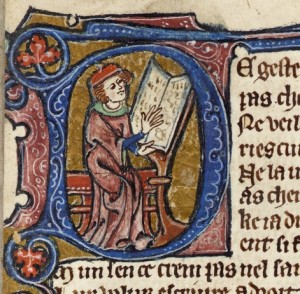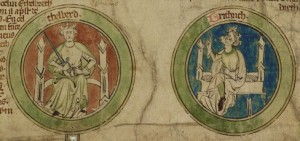The Moving Word
The Moving Word: French Medieval Manuscripts in Cambridge is the current exhibition in the Milstein Exhibition Centre, running until 17 April. On display are over fifty medieval manuscripts from the University Library, the Fitzwilliam Museum and several colleges (Christ’s, Corpus Christi, King’s, Peterhouse, St John’s and Trinity). The accompanying virtual exhibition contains additional items and video interviews with the curators. It will continue to be available after the physical exhibition closes.
The exhibition examines the role of French as an international language for the dissemination of knowledge, ideas and literary traditions across Europe and the Middle East in the later middle ages and was developed in collaboration with a wider AHRC-funded research project (http://www.medievalfrancophone.ac.uk). The project team are gathering and analysing provenance evidence relating to surviving manuscripts of key French literary texts, such as the Roman de la rose and romances such as Tristan and Lancelot. Many of these ‘French’ manuscripts were copied and circulated outside France, and texts were translated and adapted in other European vernaculars.
Cambridge collections offer numerous examples, including three Rose manuscripts from three different institutions, an important manuscript of the Lancelot-Grail cycle which was found in an old trunk in the mid-twentieth century, and a fragment of the oldest surviving version of the legend of Tristan and Isolde.
As might be expected, Cambridge libraries are particularly rich in manuscripts containing Anglo-Norman, the variety of French which developed in England with its own characteristics. The presence of Anglo-Norman alongside English in this chronicle roll, alongside Latin in the Chronica Maiora of Matthew Paris and beside both languages in the enormous compendium MS Gg.1.1 testify to the linguistic complexities of manuscript culture in England in the thirteenth and fourteenth centuries.
Intertwined with this narrative of the influence of French culture across a continent, the exhibition also traces a more intimate story – of the history of medieval French manuscripts in Cambridge. College library catalogues offer glimpses of Fellows reading French epics while the sumptuous French and Latin prayer books owned by Lady Margaret Beaufort, founder of Christ’s and St John’s, and Marie de Saint-Pol, founder of Pembroke, demonstrate the importance of the language in aristocratic courtly and religious culture. Margaret, in particular, left her mark on Cambridge, as the virtual exhibition demonstrates. The story continues with the efforts of nineteenth-century scholars such as Paul Meyer to identify and catalogue French texts in Cambridge libraries (The quest for medieval texts) and the discovery of important fragments in the bindings of later books (Scraps of treasure).
An international conference on Medieval Francophone Literary Culture Outside France will be held in Cambridge in conjunction with the exhibition on 10-12 April 2014, including a session devoted to manuscripts on display in the exhibition. For more details, visit the conference homepage.


